Retail Statistics: The Key Data, Numbers, and Growth [Updated]
Retail is a major force in the global economy and touches nearly every aspect of our daily lives.
But just how extensive is the reach of retail in today’s world?
With that in mind, we’ll cover crucial retail statistics that reveal the scope and impact of the retail sector.
Retail Statistics: The Key Numbers
- There are 9.1 million online retailers in the world, and 2.5 million of them are in the United States.
- 15.1% of U.S. retail sales are made online, while 84.9% are made in physical stores.
- According to the National Retail Federation, retail sales will rise 4%-6% in 2023, reaching $5.1-5.2 trillion.
- According to projections, total global retail will reach $31.3 trillion by 2025.
- As of 2023, the US has 1,045,422 retail stores.
- There are 2.1 million US ecommerce retailers.
- 24% of cyberattacks targeted retailers, more than any other industry.
- The retail industry had 629 incidents and 241 breaches in 2022.
- Organized retail crime accounts for 1.47% of retailer sales.
- 81% of retail shoppers conduct online research before making a purchase.
- 54% of consumers say they are more likely to look at a product online before purchasing it in-store.
Sources: (etailinsights, United States Census Bureau, Bureau of Labor, NRF, Zippa, Chad, NFR)
To learn more about retail in-depth details, we suggest you check out BusinessDasher‘s retail-related resources below.
Omnichannel Statistics: Covers key Omnichannel statistics that reveal the benefits of omnichannel strategies.
Thrift Store Industry Statistics: Cover some key thrifting statistics, as well as thrift shoppers and industry trends.
Shoplifting Statistics: Cover details of shoplifting statistics to understand the true reality of retail theft.
Augmented Reality Statistics: Cover the most crucial augmented reality retail statistics you should be aware of right away.
BOPIS Statistics: Cover key statistics about BOPIS usage.
Brick and Mortar vs. Online Statistics: Cover statistics that reveal current trends in consumer preferences.
Local Shopping Statistics: Cover the most crucial local shopping statistics that show the behavior of consumers for local shopping and other details.
Black Friday Shopping Statistics: Cover key Black Friday shopping statistics and trends that are important for you to know.
Retail Shrinkage Statistics
- The average retail shrinkage rate has hovered around 1.4% for over a decade.
- Retailers report 26.5% increases in organized retail crime, employee theft, violence, and omnichannel fraud.
- Retail shrink cost retailers $94.5 billion in 2021, 1.44% of sales.
- Retail cost increased 53.16% in last two years due to shrink.
- Most retail shrinkage is caused by external theft (37%), employee theft (28.5%), and process or control failures (25.7%).
- Retailers reported 81% shrinkage increases in 2022.
- Store theft accounts for 40% of retail shrinkage.
- The average shrink rate as a percentage of sales dropped to 1.4% in 2021 from 1.6% in 2020.
- Employee internal theft accounted for more than a quarter (28.5%) of retail shrinkage.
- In 2021, nearly twice as many businesses reported shrink rates of 3% or higher than in previous years.
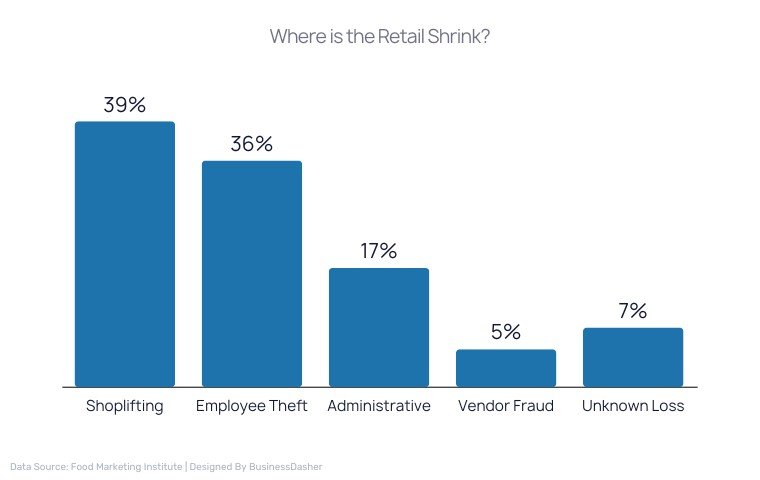
Sources: (CBS 58, Investors, Chain Storeage, NRF, Forbes, Tony Donofrio, Linkedin, CNN, CNBC, Shopify.)
Retail Foot Traffic Statistics
The retail industry has seen substantial shifts in foot traffic, with a global decline of 62.5% in 2020. Notably, retail traffic experienced an additional drop of 8.1% in March 2023 compared to March 2019.
- Retail traffic dropped 8.1% in March 2023 compared to March 2019.
- Global retail foot traffic fell by 62.5% in 2020.
- The most foot traffic increased at arts and craft supply stores (40%), department stores (34%), outlet malls (32%), and shopping centers (31%).
- Walmart, McDonald’s, and Subway have the most daily foot traffic in the U.S.
- Retail foot traffic was 3.9% higher during the week of November 7, 2021, compared to the same week in 2019.
- In Q1 2023, shopping visits rose 20% from the previous year.
- Walmart foot traffic rose 22.2%, year-over-year.
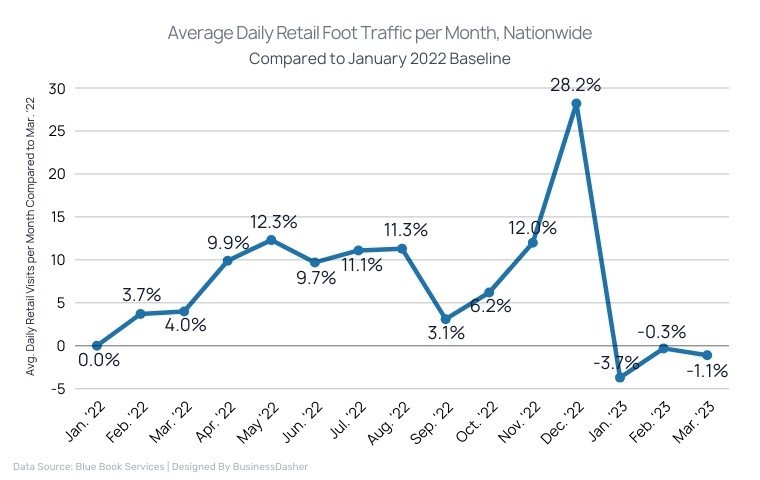
Sources: (Globest, Retail Customer Experience, Retaildive, Geekwire, Resonai, Gravy Analytics.)
AI in Retail Statistics and Market
- The market size of AI in Retail was valued at USD 6 billion in 2022 and is expected to experience a compound annual growth rate (CAGR) of over 30% from 2023 to 2032.
- In fact, it is estimated that $40 billion of additional revenue was driven by AI in retail in a 3-year span.
- 80% of retail executives expect their companies to adopt AI-powered intelligent automation by 2027.
- Currently, 4% retail use AI in their operations.
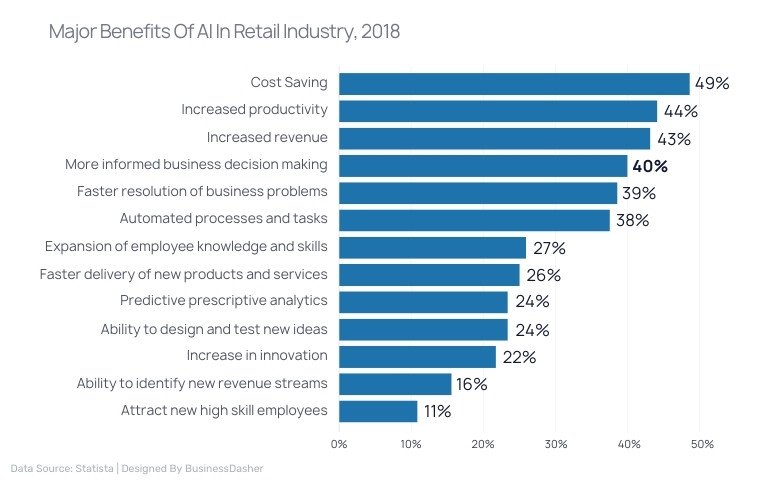
Source: (Gminsights, Hitachi, O’reilly)
Retail Food Waste Statistics
Grocery stores in the United States face a substantial issue with food waste, as about 30% of food is wasted, posing both environmental and economic challenges.
- About 30% of food is wasted by grocery stores in the United States.
- Approximately 16 billion pounds of food waste are generated annually by US retail stores.
- Food waste costs grocery stores an estimated $18.2 billion annually.
- Food waste in the retail sector is valued at roughly 2X the amount of profit generated from food sales.
- 40% of total food waste is generated at the retail level, which includes grocery stores, restaurants, and food service companies.
- The average American grocer throws away $5,000–$10,000 worth of food per week.
- The majority of this waste came from produce (32.3%), dairy and eggs (13.9%), and fresh meat and seafood (13.5%).
- In 2021, retailers produced 5.12 million tons of excess food, nearly 35% of which was disposed of in landfills or incinerated as waste.
- Due to overproduction or overordering, 67.7% of prepared foods are wasted.
- In the United States, the market share of conventional supermarkets has decreased from 69.7% in 2017 to 66.2% in 2022.
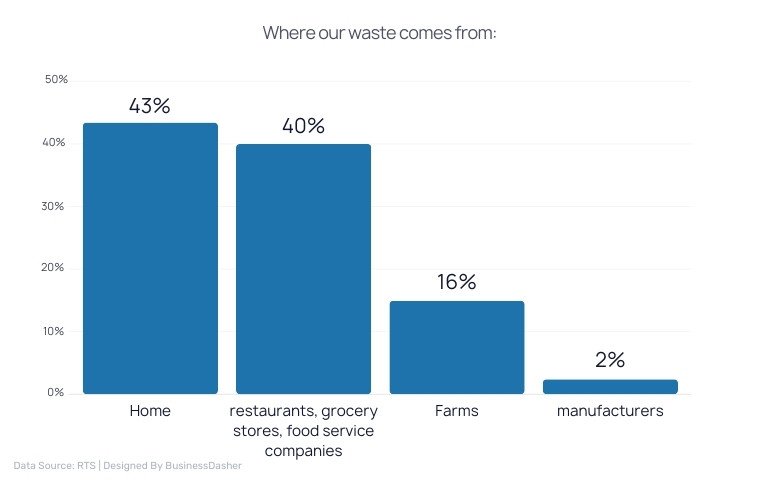
Sources: (RTS, Waste 360, Refed, Forbes, Food Engineering Mag, Winsight Grocery Business.)
Retail Investor Statistics
The engagement of retail investors is increasingly notable, with over 1.5 million buying or selling shares in 2022 and an average daily investment of $1.51 billion into U.S. stocks.
- Over 1.5 million retail investors bought or sold shares in 2022.
- Every day, retail investors poured $1.51 billion into U.S. stocks.
- 69% to 84% of retail investors experience losses.
- Retail investors make up 10% of the 3,000 largest U.S. stocks’ daily trading value.
- About 15% of retail investors started in 2020.
- 95% of retail investors live outside of major financial centers and earn average wages.
- Retail investors now account for approximately 52% of global assets under management.
- Retail investors account for nearly 20% of stock market activity in the United States.
- Retail investors bought stocks worth $76 billion during a three-month period ending on May 24, 2022.
- Retail investors’ share of total trading volume rose from just above 10% in 2011 to over 22% in 2021.
Sources: (AMF, Yahoo, Coin Telegraph, Reuters, Contrary Research, Investing In The Web, Insider Inc, The Street.)
Retail Theft Statistics
Retail theft is becoming a growing concern for businesses everywhere. By 2025, the costs tied to retail theft might reach a massive $115 billion. Retail theft costs are expected to rise by 32.79% over the next three years.
- The retail theft cost is expected to increase by 32.79% in next 3 years.
- Stores lost an estimated $86.6 billion to retail theft in 2022, with projections indicating that retail theft may cost stores over $115 billion in 2025.
- Target Stores saw a nearly 120% increase in theft incidents in the first five months of 2023
- The average theft rose from $937 in 2020 to $1,180 in 2021.
- Since 2019, major commercial locations have seen 53% more theft of items under $1,000.
- The average loss per theft incident is approximately $460.
- 74.1% of retailers reported increases in external theft from 2016 to 2021.
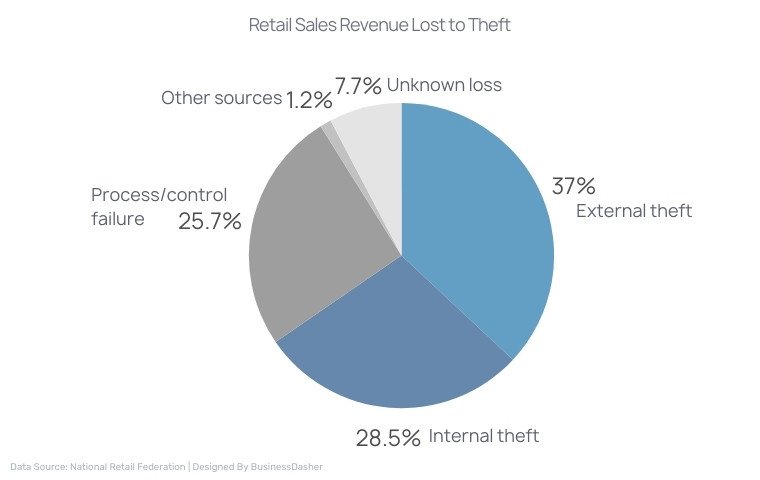
Sources: Food Institute, John Jay College of Criminal Justice, Statista, Capital One Shopping, The Hill)
Organized Retail Crime Statistics
Organized Retail Crime (ORC) is becoming a growing concern, with retailers witnessing an average 26.5% increase in ORC incidents in 2021. The crime wave led to a substantial $94 billion in inventory loss in 2022, and a worrying 75.9% of retailers have reported employee assault.
- Organized retail crime has caused $125.7 billion in lost economic activity and a loss of 658,375 jobs.
- Organized retail crime accounts for 1.47% of retailer sales.
- ORC caused $94 billion in inventory loss in 2022, and 75.9% of retailers reported employee assault.
- 56% of small retailers reported theft in 2021.
- The average theft case value was $1180 in 2021.
- In 2021, retailers saw an average 26.5% increase in ORC incidents.
- 8 out of 10 retailers reported more violence and aggression last year.
- 34% of organized retail thefts are designer clothes.
- Organized retail crime lost an average of $719,548 for every $1 billion in sales.
- Organized retail crime has cost the federal, state, and local governments $14.9 billion in lost taxes.
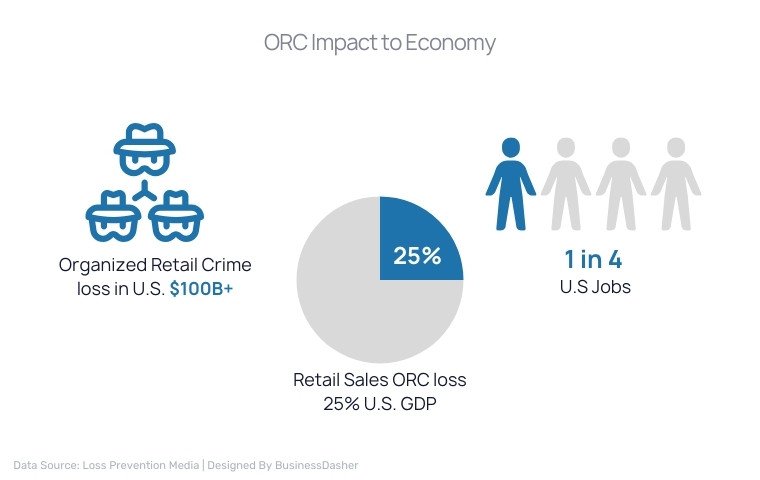
Sources: (Ri Last Age Media, NRF, ICSC, Washington Examiner, Statista, Investors, US Chamber, Legal Jobs, USA Today, Loss Prevention Media.)